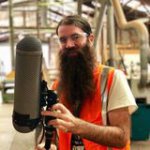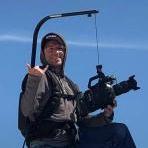
KnightsFan
-
Posts
1,352 -
Joined
-
Last visited
Reputation Activity
-
 KnightsFan got a reaction from thephoenix in Davinci Resolve 16
KnightsFan got a reaction from thephoenix in Davinci Resolve 16
You need the full version to export 4K DCI. You can go up to UHD in the free version.
You will get black bars if your delivery resolution is different from your timeline resolution. What is the resolution of your vimeo delivery?
-
 KnightsFan got a reaction from newfoundmass in Davinci Resolve 16
KnightsFan got a reaction from newfoundmass in Davinci Resolve 16
If you're coming from layers, it might help to conceptualize nodes as being similar to analog audio systems. Say you have a mic going to the input on an EQ, out to a compressor, and then to a speaker, like:
Mic -> EQ -> Compressor -> Speaker
You can stick headphones in at any stage and you hear the audio signal at that point. You aren't applying EQ to the mic, you're placing an EQ on the signal between the mic and compressor.
That's how nodes work, too. With layers it's often like you are "applying color correction to an image," whereas with nodes you're "piping the image signal through a color correction operation." You can use the viewers in Fusion like you'd use headphones on that audio path, to see what the signal looks like at any given point in the chain.
I don't know if that helps at all.
-
 KnightsFan got a reaction from newfoundmass in Davinci Resolve 16
KnightsFan got a reaction from newfoundmass in Davinci Resolve 16
Nodes are certainly much better for composites and fine tuned control of effects that don't change much over time. Layers are generally easier for motion graphics, or effects that take place over time. Just for fun, I did a recent motion graphics bit in Fusion which I would normally do in AE. It wasn't too bad at first, but it was a nightmare to retime things. I think that with a few small changes, Fusion would be almost as good as AE for motion graphics though, while keeping all the benefits of a node based compositor. Some of these may be possible already, but I just haven't learned about them yet:
- Easily make collapsible node groups / nested node graphs. You could then sort your "layers" into collapsed node graphs. This would solve the problem of a massive, un-navigable node graph
- Merge node with unlimited inputs. PixaFlux has this awesome merge node with unlimited inputs. Each layer is just composited onto the next. It saves SO much space on the graph.
- Sensible, intuitive merge options. What does an apply mode of "Normal" with an Operator of "In" mean? I have no idea, so I have to memorize what different things do. It would be so much easier to just have "Add" "Subtract" and "Multiply."
- Nodes with multiple outputs. How about an RGBA split and combine? Or keyer nodes that output the image and the matte as separate outputs?
- I still haven't figured out how to manually adjust tracking markers, or how to redo a portion of a track.
-
 KnightsFan reacted to Ryley K in Film Emulation Tutorial - Film Halation and Grain
KnightsFan reacted to Ryley K in Film Emulation Tutorial - Film Halation and Grain
Hello! I recently made a tutorial in covering how to make film halation and grain in Resolve!
I used two methods. One using the GHAlex LUTs for the GH5 and another way using Color Space Transform.
This is my first ever video tutorial so I apologize if it's a little boring and long.
Tutorial - https://www.youtube.com/watch?v=20epDbE9Adc
Here's some examples using this method - https://www.youtube.com/watch?v=luaGcO-nzd8
https://www.youtube.com/watch?v=XNQMeGqoM7o
If you like this, feel free to download the Power Grades I've provided on my website and experiment with them.
Thanks!
-
 KnightsFan reacted to Drew Veeneman in My NX1 Transcoding Ends Today!
KnightsFan reacted to Drew Veeneman in My NX1 Transcoding Ends Today!
I'm not sure if it's because I've finally upgraded to the paid Studio version of Davinci Resolve, but my NX1 footage plays flawlessly... YES! No more transcoding to DNxHR and ProRes... hot damn. This frees up a LOT of Hard Drive space.
I'm using Davinci Resolve Studio - Public Beta 2
I maybe late to the party here, but this is great. My hacked NX1 with NX-L speed booster still holds up great in 2019. The dynamic range is a little weak, however the detail retention is awesome.
-
 KnightsFan got a reaction from Cinegain in Game of Thrones ... because why not
KnightsFan got a reaction from Cinegain in Game of Thrones ... because why not
Ah, the old "it's bad, but intentionally so." Solo was too dark in many scenes, and it wasn't a question of not calibrating my TV, or watching on an ipad, or even compression. I saw it on blu ray on a 60" TV that is within reasonable calibration, in a dark room. It's funny because the Godfather, a movie famous for "underexposure," is so much easier on the eyes--because it's not about darkening a scene, it's about lighting it so that the viewer gets the impression of darkness.
...is exactly right.
-
 KnightsFan got a reaction from deezid in $10 Adobe Plan Gone
KnightsFan got a reaction from deezid in $10 Adobe Plan Gone
You're welcome! Reaper is an incredibly flexible tool that has more features and capabilities than you see at first glance. Kenny Gioia's reaper tutoroals on Youtube are a fantastic place to start also.
-
 KnightsFan reacted to IronFilm in Is 4K Worth The Tradeoff?
KnightsFan reacted to IronFilm in Is 4K Worth The Tradeoff?
Yup, who here wouldn't rather shoot with an Arri Alexa in 1080 than a RED ONE at 4K?
-
 KnightsFan got a reaction from IronFilm in Game of Thrones ... because why not
KnightsFan got a reaction from IronFilm in Game of Thrones ... because why not
Ah, the old "it's bad, but intentionally so." Solo was too dark in many scenes, and it wasn't a question of not calibrating my TV, or watching on an ipad, or even compression. I saw it on blu ray on a 60" TV that is within reasonable calibration, in a dark room. It's funny because the Godfather, a movie famous for "underexposure," is so much easier on the eyes--because it's not about darkening a scene, it's about lighting it so that the viewer gets the impression of darkness.
...is exactly right.
-
 KnightsFan reacted to Amazeballs in Is 4K Worth The Tradeoff?
KnightsFan reacted to Amazeballs in Is 4K Worth The Tradeoff?
I agree with ppl in the comments - it depends on what type of scene you shoot. If it is something with a lot of motion and shallow dof, then not that much. But if you shoot with more dof and less blur, you will clearly see it. Depends on lighting as well. I can see it very well in those scenes.
Plus, there is always a post factor - do you want to be able to crop/zoom your video, push your grade more or less.
Ofc there is a downside to 4k, a tax in disk space and computer power required to process and edit it smoothly.
-
 KnightsFan got a reaction from kaylee in $10 Adobe Plan Gone
KnightsFan got a reaction from kaylee in $10 Adobe Plan Gone
Krita is also great and does seem to have an active development community. It seems more geared towards creating artwork from scratch, with a phenomenal brush engine and great graphics tablet support. I find Gimp quicker and more intuitive for simple photo touchup with the clone and heal tools, but it could also just be that I have used it more.
-
 KnightsFan got a reaction from kaylee in $10 Adobe Plan Gone
KnightsFan got a reaction from kaylee in $10 Adobe Plan Gone
You're welcome! Reaper is an incredibly flexible tool that has more features and capabilities than you see at first glance. Kenny Gioia's reaper tutoroals on Youtube are a fantastic place to start also.
-
 KnightsFan got a reaction from kaylee in $10 Adobe Plan Gone
KnightsFan got a reaction from kaylee in $10 Adobe Plan Gone
AE: Fusion. It's not as nice for motion graphics, but much better for compositing. It's still usable for motion graphics. Fusion's tracker is phenomenal, though I still haven't quite gotten the hang of manually adjusting tracking points yet.
Audition: Reaper. Reaper completely replaces Audition multitracking, and mostly replaces the audio editor. Reaper's builtin noise reduction plugin isn't as good as Audition's, but that really the only downside I've found. Reaper works very well with VST (and other) plugins, so a third party noise reduction plugin could even out the difference.
RawTherapee is fantastic for RAW photo processing. Gimp is my goto for photo editing.
-
 KnightsFan reacted to Ivko Pivko in $10 Adobe Plan Gone
KnightsFan reacted to Ivko Pivko in $10 Adobe Plan Gone
I agree with Reaper and Fusion, there are not much alternatives there, although, and depending on the level and if you're used to layers and comps don't discredit Hitfilm. I know is not as powerful as Fusion but I see it growing every year as a viable alternative just not for fast turnaround or high level stuff yet.
And lightroom, for DAM it depends. On1 is really nice, the price is right and the tools are nice. I feel it's still a little bit clunky, not as polished as say Capture One but as with hitfilm, don't discard it because it looks it's developing quite well. It might be the age but I'm more willing to buy products from developers that listen and help them grow(and I include Blackmagic here). Or it might be my desire to find underdogs and Davids that can bring some fight to big Goliaths.
For photoshop I rather use Affinity photo but in the open source world see the development of Krita more elegant than Gimp.
-
 KnightsFan got a reaction from meudig in $10 Adobe Plan Gone
KnightsFan got a reaction from meudig in $10 Adobe Plan Gone
You're welcome! Reaper is an incredibly flexible tool that has more features and capabilities than you see at first glance. Kenny Gioia's reaper tutoroals on Youtube are a fantastic place to start also.
-
 KnightsFan got a reaction from meudig in $10 Adobe Plan Gone
KnightsFan got a reaction from meudig in $10 Adobe Plan Gone
AE: Fusion. It's not as nice for motion graphics, but much better for compositing. It's still usable for motion graphics. Fusion's tracker is phenomenal, though I still haven't quite gotten the hang of manually adjusting tracking points yet.
Audition: Reaper. Reaper completely replaces Audition multitracking, and mostly replaces the audio editor. Reaper's builtin noise reduction plugin isn't as good as Audition's, but that really the only downside I've found. Reaper works very well with VST (and other) plugins, so a third party noise reduction plugin could even out the difference.
RawTherapee is fantastic for RAW photo processing. Gimp is my goto for photo editing.
-
 KnightsFan got a reaction from Geoff CB in Game of Thrones ... because why not
KnightsFan got a reaction from Geoff CB in Game of Thrones ... because why not
I do accept that, what I'm saying is that his signature style makes me less likely to enjoy the film.
-
 KnightsFan reacted to ND64 in Game of Thrones ... because why not
KnightsFan reacted to ND64 in Game of Thrones ... because why not
We're not watching a documentary. A movie about war in the dark, shouldn't be as dark as a real war in the dark.
-
 KnightsFan got a reaction from Vintage Jimothy in Game of Thrones ... because why not
KnightsFan got a reaction from Vintage Jimothy in Game of Thrones ... because why not
I don't watch GoT so maybe the few images I've seen online are misleading, but it looks unnecessarily dark to me. Compare the screenshot at the top of this page
https://www.theverge.com/tldr/2019/4/30/18524679/game-of-thrones-battle-of-winterfell-too-dark-fabian-wagner-response-cinematographer
With another nighttime battle:
https://images.app.goo.gl/3wP5kc7T9JKKCi7m7
The LotR image is obviously nighttime: it's dark, bluish, and moody, and yet the faces are bright enough to see without any trouble, and there are spots of actual pure white in the reflections. It's the job of the cinematographer to give the impression of darkness while keeping the image clear and easy to understand.
If it were an end-user calibration problem, everyone would be complaining about every other movie as well. It seems like something was different here.
-
 KnightsFan got a reaction from kaylee in Game of Thrones ... because why not
KnightsFan got a reaction from kaylee in Game of Thrones ... because why not
I don't watch GoT so maybe the few images I've seen online are misleading, but it looks unnecessarily dark to me. Compare the screenshot at the top of this page
https://www.theverge.com/tldr/2019/4/30/18524679/game-of-thrones-battle-of-winterfell-too-dark-fabian-wagner-response-cinematographer
With another nighttime battle:
https://images.app.goo.gl/3wP5kc7T9JKKCi7m7
The LotR image is obviously nighttime: it's dark, bluish, and moody, and yet the faces are bright enough to see without any trouble, and there are spots of actual pure white in the reflections. It's the job of the cinematographer to give the impression of darkness while keeping the image clear and easy to understand.
If it were an end-user calibration problem, everyone would be complaining about every other movie as well. It seems like something was different here.
-
 KnightsFan reacted to ade towell in Eos R finally closer to it's actual value
KnightsFan reacted to ade towell in Eos R finally closer to it's actual value
How did any of you lot manage in film production a few years ago, AF has only just become semi reliable? You all talk like you can't work without it?
I'd say the RS is another major issue with the Eos-r - I've tried it and it is very noticeable and no you don't have to whip pan to see it. I had the Sony a6300 and I don't want to have to be so limited in how I move a camera again
-
 KnightsFan got a reaction from IronFilm in Nikon Z6 features 4K N-LOG, 10bit HDMI output and 120fps 1080p
KnightsFan got a reaction from IronFilm in Nikon Z6 features 4K N-LOG, 10bit HDMI output and 120fps 1080p
I've read that FF is more expensive than APS-C because the same number of defects on a wafer will mean a lower percentage yield if you are cutting larger sensors off of that wafer. In other words, 5 defects on a wafer that will be cut into 100 sensors could mean 5 defective sensors and 95 good ones, 95% yield in the worst case. If you are only cutting 4 sensors off of that wafer, those same 5 defects give you a 75% yield at best.
The conclusion is that a large sensor is actually more expensive per sq. mm than a smaller sensor. I'm not sure what the actual numbers are--maybe it is just a $150 difference as you read.
-
 KnightsFan got a reaction from IronFilm in Nikon Z6 features 4K N-LOG, 10bit HDMI output and 120fps 1080p
KnightsFan got a reaction from IronFilm in Nikon Z6 features 4K N-LOG, 10bit HDMI output and 120fps 1080p
The GH5 also totally destroys the A6500. I believe the A6500 is one of the main reasons there is a general negativity towards Sony. It has odd color (to be generous) and the worst possible rolling shutter.
I think we all know how big sensors are. Size does not necessarily mean more detail, or better image, a lot of that is determined by the processing done afterwards. And sensor size has nothing to do with the amount of data unless you keep pixel pitch the same. I think the GH5's 4:3 open gate mode records more pixels/data than the Z6 in 16:9 UHD, and certainly packs it into a beefier codec.
From what I have seen, the Z6 doesn't have a particularly good image, compared to a GH5 at native ISO. Maybe that's because I've actually worked with Gh5 footage on real projects, whereas I've only downloaded test clips of the Z6. But the GH5 holds up better to grading with high data rates. I haven't tried to work with any externally recorded Z6 footage yet, but, as soon as you require an external recorder attached with a feeble HDMI cable, you've really lost my interest. It's a workaround to the fact that many DSLR-style cameras don't come with the video codecs and tools we need.
That isn't to say the Z6 is bad. I'd rather have a Z6 than a GH5, but it's not because the video image fidelity is better at native ISO. Low light is much better, and full frame means I'd use vintage lenses at their native FOV. But I really think it's a trade off with the current batch of smaller sensor cameras that have more video-oriented features.
-
 KnightsFan got a reaction from frontfocus in Nikon Z6 features 4K N-LOG, 10bit HDMI output and 120fps 1080p
KnightsFan got a reaction from frontfocus in Nikon Z6 features 4K N-LOG, 10bit HDMI output and 120fps 1080p
The GH5 also totally destroys the A6500. I believe the A6500 is one of the main reasons there is a general negativity towards Sony. It has odd color (to be generous) and the worst possible rolling shutter.
I think we all know how big sensors are. Size does not necessarily mean more detail, or better image, a lot of that is determined by the processing done afterwards. And sensor size has nothing to do with the amount of data unless you keep pixel pitch the same. I think the GH5's 4:3 open gate mode records more pixels/data than the Z6 in 16:9 UHD, and certainly packs it into a beefier codec.
From what I have seen, the Z6 doesn't have a particularly good image, compared to a GH5 at native ISO. Maybe that's because I've actually worked with Gh5 footage on real projects, whereas I've only downloaded test clips of the Z6. But the GH5 holds up better to grading with high data rates. I haven't tried to work with any externally recorded Z6 footage yet, but, as soon as you require an external recorder attached with a feeble HDMI cable, you've really lost my interest. It's a workaround to the fact that many DSLR-style cameras don't come with the video codecs and tools we need.
That isn't to say the Z6 is bad. I'd rather have a Z6 than a GH5, but it's not because the video image fidelity is better at native ISO. Low light is much better, and full frame means I'd use vintage lenses at their native FOV. But I really think it's a trade off with the current batch of smaller sensor cameras that have more video-oriented features.
-
 KnightsFan got a reaction from webrunner5 in Nikon Z6 features 4K N-LOG, 10bit HDMI output and 120fps 1080p
KnightsFan got a reaction from webrunner5 in Nikon Z6 features 4K N-LOG, 10bit HDMI output and 120fps 1080p
The GH5 also totally destroys the A6500. I believe the A6500 is one of the main reasons there is a general negativity towards Sony. It has odd color (to be generous) and the worst possible rolling shutter.
I think we all know how big sensors are. Size does not necessarily mean more detail, or better image, a lot of that is determined by the processing done afterwards. And sensor size has nothing to do with the amount of data unless you keep pixel pitch the same. I think the GH5's 4:3 open gate mode records more pixels/data than the Z6 in 16:9 UHD, and certainly packs it into a beefier codec.
From what I have seen, the Z6 doesn't have a particularly good image, compared to a GH5 at native ISO. Maybe that's because I've actually worked with Gh5 footage on real projects, whereas I've only downloaded test clips of the Z6. But the GH5 holds up better to grading with high data rates. I haven't tried to work with any externally recorded Z6 footage yet, but, as soon as you require an external recorder attached with a feeble HDMI cable, you've really lost my interest. It's a workaround to the fact that many DSLR-style cameras don't come with the video codecs and tools we need.
That isn't to say the Z6 is bad. I'd rather have a Z6 than a GH5, but it's not because the video image fidelity is better at native ISO. Low light is much better, and full frame means I'd use vintage lenses at their native FOV. But I really think it's a trade off with the current batch of smaller sensor cameras that have more video-oriented features.







